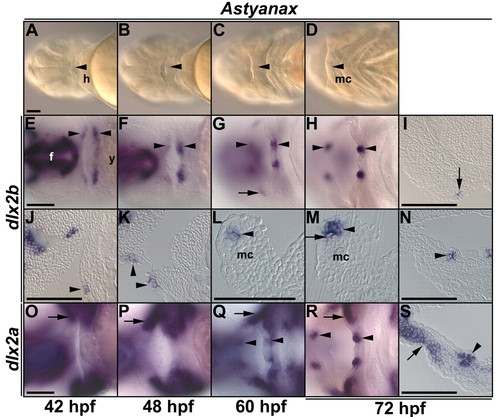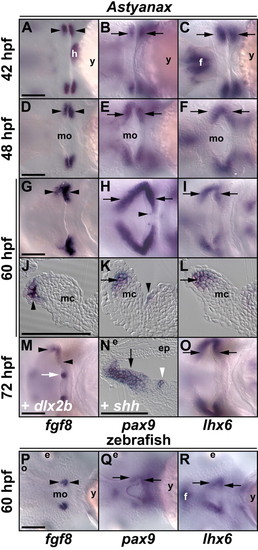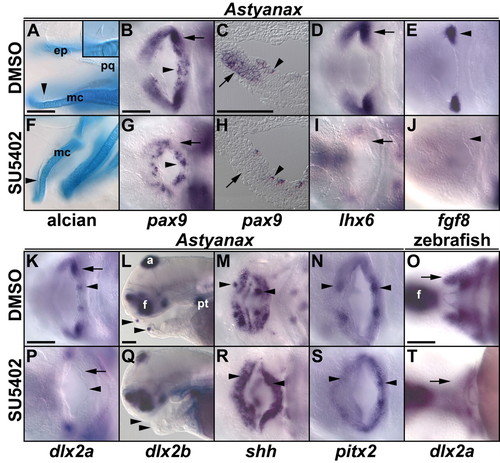- Title
-
Developmental genetic mechanisms of evolutionary tooth loss in cypriniform fishes
- Authors
- Stock, D.W., Jackman, W.R., and Trapani, J.
- Source
- Full text @ Development
|
Oral morphology in Astyanax and zebrafish. (A) Teeth are present on premaxillary (p), maxillary (m) and dentary bones (d, arrowhead) of adult Astyanax (lateral view, cleared and stained with Alcian blue and Alizarin red). (B,C) A single tooth is present on each premaxillary and dentary bone in 120 hpf Astyanax (frontal views; teeth and bones digitally colored red in B). (D-F) Bell-shaped tooth germs in 72 hpf Astyanax lower jaw. Dental epithelium indicated by arrowhead, darkly-stained dental mesenchyme by arrow. Transverse sections in D,E; sagittal in F. (G) Toothless oral cavity of adult zebrafish. (H) Toothless oral cavity of 124 hpf zebrafish larva cleared and stained with Alcian green. (I-L) No tooth germs are visible in sectioned, Toluidine blue-stained zebrafish larvae. (I,J) Identical transverse sections of a 72 hpf specimen. (K,L) Sagittal views of the lower jaw of 72 hpf and 120 hpf specimens, respectively. d, dentary; e, eye; ep, ethmoid plate; m, maxillary; mc, Meckel's cartilage; n, neuromast; o, olfactory organ; ov, oral valve; p, premaxillary; t, trabecula. Scale bars: 1 mm in A,G; 100 μm in B,D,H,I; 50 μm in C,E,F,J-L. |
|
Expression of Astyanax Dlx2 orthologs. (A-D) Anterior progression of mouth in live larvae (ventral views, anterior to left). Arrowhead indicates lower jaw. (E-H) dlx2b expression in ventral whole mount (anterior to left). Arrowheads indicate putative odontogenic epithelium. Arrow indicates additional faint epithelial expression domain in a maxillary process unlikely to be related to dentition. (I) Transverse section showing dlx2b expression in epithelium of the upper tooth germ (arrow). (J-M) dlx2b expression in sagittal sections. Odontogenic epithelium labeled as in E-H. Note the mineralization in M (arrow). (N) Transverse section showing dlx2b expression in epithelium of the mandibular tooth germ (arrowhead). (O-S) dlx2a expression in ventral whole mount (O-R) and transverse section (S). Arrowheads indicate odontogenic epithelium and arrows expression in lateral jaw mesenchyme. Note expression in the epithelium (arrowhead) and mesenchyme of the tooth germ in S. f, forebrain; h, heart; mc, Meckel's cartilage; y, yolk. Scale bars: 100 μM. |
|
Expression of Dlx2 orthologs in zebrafish, Synodontis and medaka. (A-C) dlx2b expression is absent at all stages from the zebrafish oral region, but present in forebrain (f). (D-F) dlx2a expression is absent from zebrafish oral epithelium at all stages, but present laterally in jaw mesenchyme (arrows) and forebrain. (G-L) dlx2a and dlx2b are expressed in tooth germs of Synodontis, while only dlx2a is expressed laterally in the jaw mesenchyme (arrows in J,K) and barbels (arrow in L). Both genes are expressed (arrowheads) in tooth germ epithelium (cytodifferentiation stage premaxillary germ in G; initiation stage dentary germ in J), and dlx2b was additionally detected in tooth germ mesenchyme (arrow in G). Arrowheads indicate one of three premaxillary germs per side in H, one of two dentary germs per side in K, and one of numerous germs visible in upper and lower jaws of I,L. (M-O) Medaka dlx2a is expressed in oral epithelium (arrowheads in M,N) and mesenchyme (arrows in M-O). Transverse section (M) indicates epithelium expression is in a medial band and sagittal sections (N,O) reveal that mesenchymal expression is lateral to this. Indicated stage is before visible signs of tooth initiation. All whole mounts in ventral view; transverse sections in B,E-G,J,M; sagittal sections in N,O. Abbreviations as in Fig. 1. f, forebrain; mx, maxillary process; y, yolk. Scale bars: 100 μm in A-H,J-K,M-O; 500 μm in I,L. |
|
Expression of Pitx2 and Shh in Astyanax and zebrafish. (A-C) pitx2 is expressed broadly and uniformly in the Astyanax oral region at early stages, later becoming strongest in tooth germs (arrowheads). (D-F) Sagittal sections reveal epithelial pitx2 expression (arrowheads) that includes morphologically visible tooth germs (arrow indicates mineralized matrix) and the oral valve (ov). (G-I) Astyanax shh expression is initially broad, becoming discrete in tooth germs by 72 hpf (arrowheads). (J-L) Sagittal sections reveal shh expression (arrowheads) to be epithelial and more posteriorly (lingually) restricted than pitx2. (L) At 72 hpf, shh expression is discontinuous between tooth germ (arrow) and oral valve. Arrow indicates mineralized matrix. (M-O) pitx2 is broadly expressed in zebrafish oral epithelium. Sagittal (N) and transverse (O) sections indicate labially restricted expression (arrowhead). No discrete expression corresponding to tooth germs is seen at any stage. (P-R) shh is expressed in zebrafish oral epithelium (arrowheads), showing little overlap with pitx2 expression, to which it is lingual. Abbreviations as in Fig. 1. y, yolk. Scale bars: 100 μm. |
|
Expression of putative Fgf signaling pathway components in Astyanax and zebrafish. (A-R) fgf8, dlx2b, pax9 and lhx6 expression. (A,D,G,J) Astyanax fgf8 is expressed in maxillary and mandibular epithelium of the developing mandibular arch (arrowheads), with expression domains moving medially between 42 and 48 hpf. (M) Medial limits of fgf8 expression (arrowheads) do not overlap with dlx2b expression (arrow) when detected simultaneously. (P) Zebrafish fgf8 expression resembles that in Astyanax. (B,E,H,K) Astyanax pax9 is expressed predominantly in the maxillary and mandibular mesenchyme (arrows), but is also found in patches in the oral epithelium (arrowheads). (N) Simultaneous detection of shh (arrowhead) and pax9 (arrow) indicates that pax9 mesenchymal expression is strongest lateral to the developing tooth germ (arrowhead). (Q) Zebrafish pax9 expression (arrows) resembles that in Astyanax. (C,F,I,L,O) Astyanax lhx6 is expressed in the maxillary and mandibular mesenchyme (arrows). (R) Zebrafish lhx6 expression (arrows) resembles that in Astyanax. (J-L) Sagittal sections of mandible; (N) transverse section. Abbreviations as in Fig. 1. f, forebrain; h, heart; mo, mouth opening; y, yolk. Scale bars: 100 μm. EXPRESSION / LABELING:
|
|
Targets of Fgf signaling investigated by SU5402 treatment, with DMSO control. (A,F) Alcian green staining reveals a loss of oral teeth (arrowhead and inset in A) following SU5402 treatment. Arrowhead indicates dentary bone in F. (B,C,G,H) Mesenchymal (arrow), but not epithelial (arrowhead), expression of Astyanax pax9 is absent after SU5402 treatment. Mesenchymal expression of lhx6 (D,I, arrows), epithelial expression of fgf8 (E,J, arrowheads) and dlx2b (L,Q, arrowheads), and both mesenchymal (arrow) and epithelial (arrowhead) expression of dlx2a (K,P) in the oral region are absent after SU5402 treatment in Astyanax. (M,N,R,S) Oral epithelial expression of shh and pitx2 remains after SU5402 treatment in Astyanax. (O,T) Mandibular arch mesenchymal expression of dlx2a (arrow) in the zebrafish is absent after SU5402 treatment. (B,D-E,G,I-K,M-P,R-T) Whole-mount ventral views; (A,F,L,Q) lateral views; (C,H) transverse sections. Abbreviations as in Fig. 1. a, adhesive gland; f, forebrain; pq, palatoquadrate; pt, pharyngeal tooth. Scale bars: 100 μm. EXPRESSION / LABELING:
|






